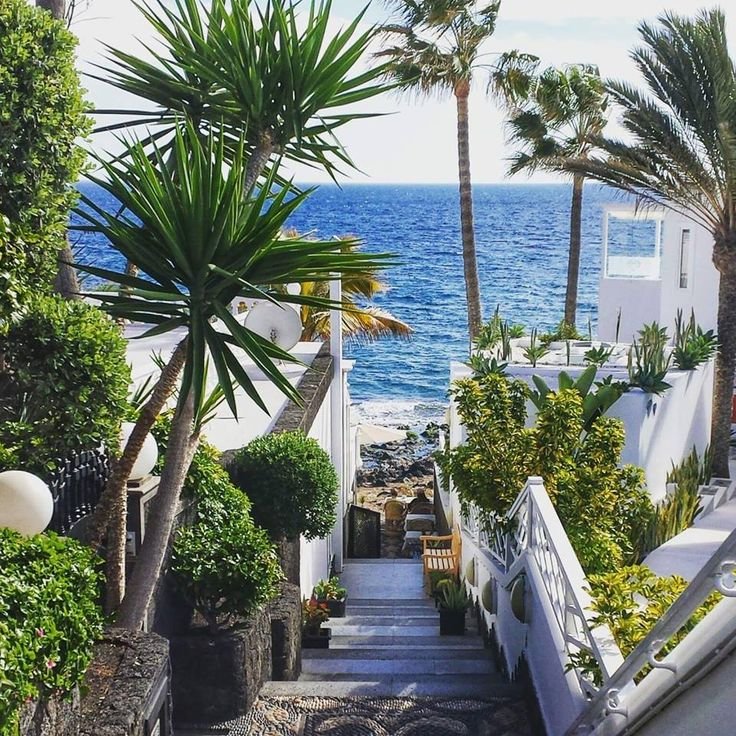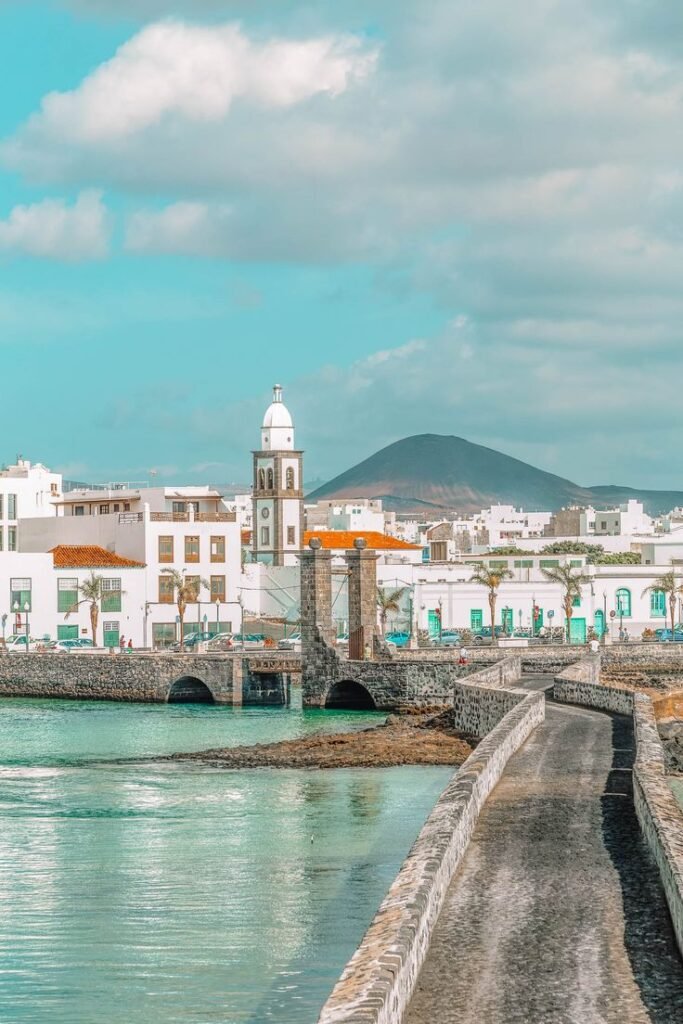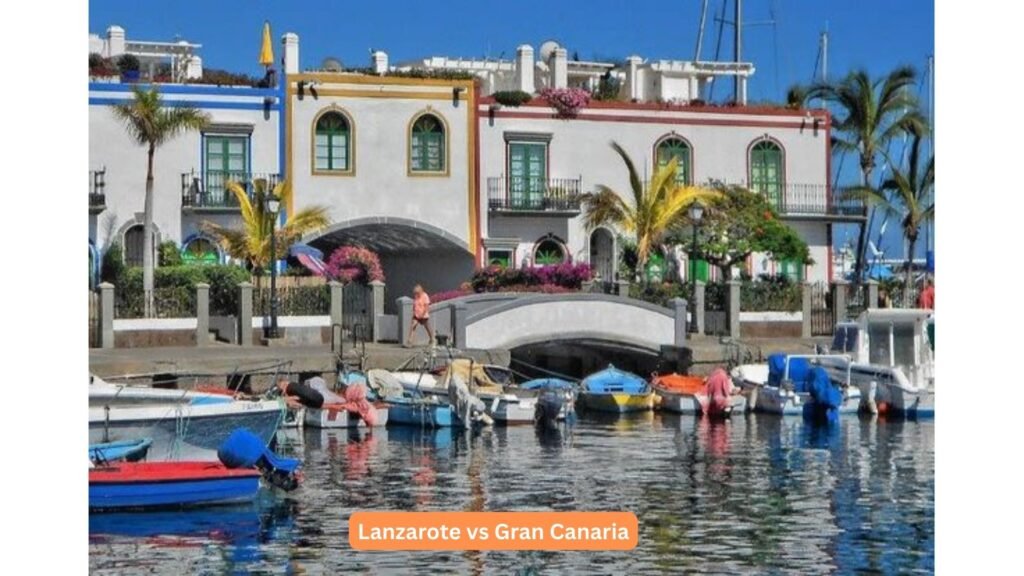Are you dreaming of volcanic landscapes or golden beaches? Seeking tranquil seclusion or vibrant nightlife? The eternal Lanzarote vs Gran Canaria debate has puzzled countless travelers planning their ideal Canary Islands getaway. When comparing Lanzarote vs Gran Canaria, you’ll discover two jewels of the archipelago that offer distinctly different experiences, each with their own unique charm and allure. As someone who has explored every corner of these magnificent islands over the past fifteen years, I’m here to help you navigate this Lanzarote vs Gran Canaria dilemma and find your perfect island match.
Overview: Two Distinct Personalities of the Canaries
The Canary Islands, Spain’s sun-drenched archipelago floating off the northwest coast of Africa, boast year-round sunshine and dramatically diverse landscapes. While all seven main islands share a common volcanic heritage, Lanzarote vs Gran Canaria reveals two destinations that have evolved into completely different experiences that cater to distinct traveler preferences.
Lanzarote, the easternmost of the Canary Islands, captivates visitors with its otherworldly volcanic terrain, artistic heritage, and commitment to sustainable tourism. Often described as “lunar” or “Martian,” the island’s protected landscapes have earned it UNESCO Biosphere Reserve status. Here, the vision of local artist César Manrique has shaped development to harmonize with nature rather than overwhelm it.
Gran Canaria, meanwhile, presents a miniature continent of diverse microclimates and landscapes. From the golden dunes of Maspalomas to the verdant ravines of the interior and the buzzing capital of Las Palmas, Gran Canaria offers greater diversity in a more developed package. The island balances tourism with agriculture, traditional villages, and vibrant city life.
Key Differences Between Lanzarote vs Gran Canaria
When comparing Lanzarote vs Gran Canaria, several key differences emerge:
- Landscape Character: Lanzarote showcases stark, minimalist volcanic beauty with protected lava fields and dramatic black shores, while Gran Canaria presents a varied topography transitioning from desert-like southern beaches to lush northern valleys and rugged central mountains, earning it the nickname “continent in miniature.”
- Development Style: Lanzarote maintains strict building regulations limiting structures to three stories and favoring white-washed buildings with green or blue woodwork in harmony with the landscape, whereas Gran Canaria features more extensive tourist infrastructure with high-rise resort complexes in southern areas like Playa del Inglés and Puerto Rico, contrasting with its charming traditional villages inland.
- Visitor Experience: Lanzarote offers a more tranquil, nature-focused experience emphasizing geothermal wonders, art installations, and pristine protected areas, while Gran Canaria delivers greater variety with bustling resort areas, extensive shopping options, and a renowned nightlife scene alongside opportunities for mountain adventures.
Climate and Best Time to Visit: Subtle Differences in Year-Round Sunshine
Both islands enjoy the Canaries’ famous “eternal spring” climate, but subtle differences exist that might influence your decision. Lanzarote and Gran Canaria both boast over 300 sunny days annually, but their topographies create distinct weather patterns worth considering when planning your trip.
Climate Characteristics
In the Lanzarote vs Gran Canaria climate comparison, Lanzarote, being flatter and more exposed, experiences stronger winds year-round. These trade winds, while providing welcome cooling during summer months, can make beaches occasionally challenging for sunbathing but perfect for windsurfing and kitesurfing. The island receives very little rainfall (around 140mm annually), concentrated in winter months, making it the driest of the Canaries.
Gran Canaria’s more mountainous profile creates numerous microclimates. The south remains consistently sunny and warm, while the north experiences more cloud coverage and rainfall, resulting in lusher landscapes. This diversity means that on a single day, you might experience different weather conditions as you travel across the island.

Temperature and Seasonal Differences
When considering Lanzarote vs Gran Canaria temperatures throughout the year:
- Summer (June-September): Lanzarote typically experiences average highs of 28-30°C (82-86°F) with cooling breezes making it feel less intense, despite lower humidity levels that create a drier heat sensation than mainland Spain, whereas Gran Canaria’s southern resorts reach similar temperatures but can feel hotter due to less consistent winds, while northern areas like Las Palmas enjoy more moderate temperatures around 26-28°C (79-82°F) with occasional cloud coverage providing natural cooling.
- Winter (December-February): Lanzarote maintains pleasant daytime temperatures averaging 21-23°C (70-73°F) with cooler evenings dropping to around 14-16°C (57-61°F), making it an excellent winter sun destination despite occasional stronger winds and brief rainfall periods, while Gran Canaria offers slightly warmer southern winter temperatures of 22-24°C (72-75°F) and greener northern landscapes due to seasonal rainfall that creates spectacular mountain scenery during this period.
- Best Visiting Times: Lanzarote shines during May-June and September-October when temperatures are perfect for combining beach time with exploration of volcanic sites without summer crowds or winter wind peaks, whereas Gran Canaria offers year-round appeal with southern beaches providing reliable sunshine even in winter months when northern European visitors flock to escape cold weather, while spring (April-May) delivers spectacular wildflower displays in the mountainous interior.
Discover also
Landscapes and Beaches: Volcanic Drama vs. Diverse Terrains
The most striking contrast in the Lanzarote vs Gran Canaria comparison lies in their landscapes and beaches, each offering distinctive natural wonders that appeal to different aesthetic sensibilities and vacation preferences.
Lanzarote’s UNESCO-protected volcanic landscape creates a mesmerizing, almost cinematic backdrop for your holiday. The centerpiece, Timanfaya National Park, showcases rust-colored volcanic cones and solidified lava flows where demonstrations of geothermal activity—from geyser-like steam eruptions to barbecuing over natural heat vents—leave visitors spellbound. The island’s beaches range from golden stretches like Playa Blanca to unique black volcanic sand coves and natural swimming pools carved into lava rock.
Gran Canaria counters with remarkable diversity packed into its circular territory. The famous dunes of Maspalomas in the south create a miniature Sahara meeting the Atlantic, while the central highlands feature dramatic peaks, deep ravines, and pine forests reminiscent of Alpine landscapes. The island’s northern coastline offers rugged cliffs and lush valleys, completing its “continent in miniature” reputation.
Beach Comparison: Lanzarote vs Gran Canaria
Beach experiences differ dramatically when comparing Lanzarote vs Gran Canaria:
- Lanzarote’s Signature Beaches: Papagayo’s protected golden-sand coves near Playa Blanca offer crystal-clear turquoise waters accessible via scenic clifftop walks, creating intimate swimming experiences despite lack of facilities beyond the main beach, while Famara Beach presents a dramatic 6km stretch backed by towering cliffs where experienced surfers ride Atlantic waves alongside breathtaking sunset views that photographers travel specifically to capture.
- Gran Canaria’s Beach Diversity: Maspalomas and Playa del Inglés form an impressive 6km golden coastline bordered by protected dunes where visitors can choose between developed sections with sunbeds and watersports or seek seclusion among the rolling sand hills that shift continuously with the winds, while natural treasures like Güigüi Beach reward adventurous hikers with pristine black sand shores accessible only by boat or challenging trails, offering a complete escape from the island’s more commercial face.
- Unique Natural Features: Lanzarote’s Charco de los Clicos (Green Lagoon) in El Golfo presents a striking emerald-green lagoon against black sand and red volcanic cliffs that creates one of the Canaries’ most photographed natural phenomena due to its otherworldly color contrast created by unique algae, whereas Gran Canaria’s Roque Nublo stands as a 67-meter natural rock monument at nearly 1,700 meters elevation, offering hikers panoramic views stretching across the island to Tenerife’s Mount Teide on clear days.
Activities and Experiences: From Artistic Heritage to Adventure Sports
The experiences available on each island reflect their distinct characters, with Lanzarote emphasizing artistic and geological wonders while Gran Canaria offers greater variety and scale of activities.
Lanzarote’s cultural identity is inseparable from César Manrique, whose architectural interventions transformed the island into a large-scale art project. His stunning creations—including Jameos del Agua (a concert hall built in a volcanic tube), the Cactus Garden, and his own former home built into volcanic bubbles—represent a harmonious fusion of nature and human creativity. Beyond these attractions, the island excels in water sports, with world-class conditions for windsurfing and diving.
Gran Canaria counters with a broader range of activities spanning urban cultural experiences in Las Palmas to rural adventures in its mountainous interior. The island’s more developed tourism infrastructure supports everything from family water parks to challenging mountain biking trails and renowned annual events like its famous Carnival.
Signature experiences for active travelers include:
- Water-Based Activities: Lanzarote’s consistent trade winds have established it as one of Europe’s premier windsurfing and kitesurfing destinations, particularly in Costa Teguise and Famara where international competitions take place annually and schools offer instruction for all levels amid reliable conditions, whereas Gran Canaria shines with greater diversity in water experiences, including dolphin and whale watching excursions departing from Puerto Rico with high sighting success rates, alongside family-friendly water parks like Aqualand Maspalomas featuring slides and pools for various ages.
- Land Adventures: Lanzarote offers unique volcano hiking experiences through landscapes reminiscent of Mars, particularly in Timanfaya National Park where guided walks traverse solidified lava flows and volcanic tubes while explaining the dramatic 1730s eruptions that transformed one-third of the island, while Gran Canaria’s extensive network of hiking trails (over 300km) includes the spectacular Ruta de Plata crossing the island through changing ecosystems from pine forests to rocky peaks with overnight options in mountain refuges.
- Cultural Experiences: Lanzarote’s wine region in La Geria presents a fascinating cultural landscape where vines grow in individual hand-dug pits protected by semi-circular stone walls, creating a geometric pattern visible for miles where traditional bodegas offer tastings of volcanic-soil wines with distinctive minerality, while Gran Canaria’s historic old quarter of Vegueta in Las Palmas features Renaissance architecture, Columbus House Museum, and the Atlantic Centre of Modern Art alongside bustling tapas streets like Calle Mendizábal where locals gather nightly.

Accommodation and Staying Options: Boutique Charm vs. Resort Variety
The accommodation offerings on each island reflect their different development philosophies and target audiences, with Lanzarote favoring smaller-scale, architecturally interesting options while Gran Canaria offers greater variety and more large resorts.
Lanzarote’s strict building regulations (no structures over three stories, predominantly white with green or blue trim) have created a cohesive aesthetic across the island. The main resort areas of Puerto del Carmen, Costa Teguise, and Playa Blanca offer a range of options, but even larger hotels maintain a certain restraint. The island excels in boutique experiences, from cave accommodations to design-focused rural hotels that incorporate volcanic elements.
Gran Canaria’s longer tourism history has resulted in more extensive and varied accommodation options. The southern resort corridor from Maspalomas through Playa del Inglés to Puerto Rico features larger hotel complexes and apartment towers catering to mass tourism, while the capital Las Palmas offers urban stays, and the interior provides rustic finca experiences.
Notable accommodation differences include:
- Luxury Experiences: Lanzarote’s luxury accommodations emphasize integration with the landscape, exemplified by Princess Yaiza Suite Resort in Playa Blanca with its low-rise Canarian village design featuring interior gardens, multiple pools, and thalassotherapy spa utilizing local volcanic elements, whereas Gran Canaria’s Seaside Grand Hotel Residencia in Maspalomas stands as one of the Canaries’ most exclusive properties, designed by acclaimed architect Alberto Pinto with colonial styling, private terraces, and personalized service that has attracted celebrity guests.
- Family-Friendly Options: Lanzarote’s H10 Rubicón Palace combines family amenities including extensive children’s pools, supervised clubs for different age groups, and specially designed family rooms while maintaining architectural harmony with the island’s aesthetic guidelines and offering views of neighboring Fuerteventura, while Gran Canaria’s Lopesan Baobab Resort creates an African-themed experience with extensive pool landscapes resembling Savannah watering holes, adventure playground areas, and spacious family suites adjacent to Maspalomas nature reserve.
- Unique Stays: Lanzarote features truly one-of-a-kind accommodations like Eco Finca de Arrieta, an off-grid complex of yurts and converted stone buildings powered by solar and wind energy where guests collect eggs from resident chickens and experience sustainable living without sacrificing comfort, whereas Gran Canaria’s historic Hotel Rural Las Tirajanas perches spectacularly at 1,000 meters elevation amid pine forests and offers rooms with panoramic valley views, traditional Canarian architecture, and access to countless hiking trails directly from the property.
Local Cuisine and Dining: Similar Roots, Different Experiences
The culinary traditions of both islands share Canarian foundations but offer different dining experiences reflecting their individual characters and development patterns.
Canarian cuisine centers around fresh, simple ingredients—locally caught fish, goat and sheep cheeses, tropical fruits, and unique local potatoes called “papas arrugadas” served with spicy mojo sauces. Both islands feature these staples, but their presentation and dining atmospheres differ significantly.
Lanzarote’s food scene emphasizes authentic experiences in dramatic settings. The island’s agricultural areas produce distinctive wines from grapes grown in volcanic ash, and many restaurants incorporate magnificent views of the lunar landscape. El Golfo village is renowned for seafood restaurants perched directly over the Atlantic with dramatic sunset views.
Gran Canaria offers greater diversity, from sophisticated dining in Las Palmas to traditional mountain village restaurants and international options in tourist areas. The island produces tropical fruits, almonds, and unique coffee grown in northern valleys, adding to its culinary palette.
Distinctive food experiences include:
- Signature Dining Experiences: Lanzarote’s El Diablo Restaurant in Timanfaya National Park grills meats directly over a volcanic heat vent at 400°C, creating a uniquely flavored dining experience where the cooking method harnesses geothermal energy while diners enjoy panoramic views of the Fire Mountains’ otherworldly landscape, whereas Gran Canaria’s Casa Montesdeoca in Las Palmas occupies a meticulously restored 16th-century mansion built around a traditional Canarian courtyard where traditional recipes meet contemporary presentations amid historic architecture filled with antiques and art.
- Local Specialties: Lanzarote’s volcanic wines from La Geria, particularly the dry white Malvasía volcanica varietal, develop distinctive mineral qualities from ash-covered vineyards visible during bodega visits where traditional production methods continue alongside innovative organic approaches pioneered by wineries like Bodega Los Bermejos, while Gran Canaria’s unique contribution to Canarian cuisine comes from inland areas producing award-winning cheeses like Flor de Guía, created using vegetable rennet from cardoon thistles through traditional methods demonstrated at cheese farms like Finca de Uga where visitors witness the entire production process.
- Market Experiences: Lanzarote’s Teguise Sunday Market combines craft products, local foods, and live music in the island’s historic former capital creating a cultural experience beyond shopping where visitors can sample local specialties like gofio (toasted grain flour) prepared in traditional ways amid colonial architecture, while Gran Canaria’s Mercado de Vegueta in Las Palmas houses dozens of specialist food vendors under one historic roof where locals have shopped for generations, offering the opportunity to sample diverse Spanish hams, Canarian cheeses, tropical fruits, and freshly prepared tapas at market bars.
Transportation and Getting Around: Navigating Island Differences
The transportation experiences between these islands differ significantly based on their size, topography, and development patterns, affecting how visitors explore each destination.
Lanzarote, being smaller (846 km²) and less mountainous, is relatively straightforward to navigate. The compact size means most attractions lie within a 45-minute drive from central locations. The island’s excellent road system connects the main points of interest with well-maintained highways, though some attractions like certain beaches require navigation via unpaved tracks.
Gran Canaria, significantly larger (1,560 km²) and more mountainous, presents a more complex transportation challenge. The island’s circular highway provides efficient coastal connections, but the dramatic central highlands feature winding mountain roads with hairpin turns that are both challenging and spectacular. Distances that appear short on maps can require considerable driving time due to terrain.
Transportation considerations include:
- Rental Car Experiences: Lanzarote’s compact size makes a rental car the most efficient option for exploration, with attractions like Timanfaya National Park and the northern art sites easily combined in single-day itineraries without excessive driving, while parking remains relatively straightforward even at popular sites during peak season, whereas Gran Canaria requires more strategic planning for car rental, particularly when combining coastal areas with mountain villages like Tejeda or Cruz de Tejeda where narrow roads demand confident driving skills but reward with spectacular vistas across ravines and peaks.
- Public Transportation Options: Lanzarote’s public bus network (Intercity Bus Line) connects major towns and attractions with reasonably frequent service particularly between Puerto del Carmen, Arrecife, and Costa Teguise, though service to remote northern attractions like Famara or La Graciosa ferry requires planning around limited departures, while Gran Canaria offers a more comprehensive public transportation network including the convenient Global bus company connecting Las Palmas with southern resorts via regular service as well as mountain villages, supplemented by Las Palmas’ urban bus network and a growing urban bicycle sharing system.
- Unique Transport Experiences: Lanzarote offers visitor access to the small neighboring island of La Graciosa via a 30-minute ferry from Órzola, opening exploration of pristine beaches without cars as only residents may bring vehicles to this tranquil island where walking and cycling paths connect sandy coves, whereas Gran Canaria features a historic wooden tram in the Bandama area traveling through volcanic landscape to wine country, plus the Fred Olsen high-speed ferry connecting with neighboring Tenerife for potential day trips between islands for those wanting to experience both Canarian superstars.

Travel Tips and Costs: Planning Your Perfect Island Stay
Understanding the practical aspects and relative costs of visiting each island helps travelers make informed decisions based on their preferences and budget constraints.
Lanzarote generally offers a slightly more affordable experience overall, particularly in accommodation and dining outside the peak Christmas/New Year and Easter periods. The island’s attractions focus on natural and artistic sites with moderate entrance fees, and many beaches and viewpoints remain free to access. The concentrated nature of tourism in specific areas means that venturing slightly off the beaten path can quickly reduce costs.
Gran Canaria presents more variable pricing depending on location and season. Southern resort areas command premium prices, especially during winter months when northern European visitors seek sunshine escapes. However, exploring the capital Las Palmas or mountain villages can offer excellent value, with authentic experiences at lower prices than tourist zones.
Practical considerations for budget-conscious travelers include:
- Accommodation Costs: Lanzarote’s mid-range accommodations typically cost 15-20% less than equivalent properties in Gran Canaria’s southern resort areas during peak winter season, though summer prices equalize significantly across both islands when European school holidays bring different visitor demographics to the archipelago, while self-catering apartments in Puerto del Carmen often represent Lanzarote’s best value option for longer stays, whereas Gran Canaria offers greater budget extremes, from premium prices for exclusive Maspalomas properties to exceptionally affordable rural tourism initiatives in interior villages like San Bartolomé de Tirajana where restored traditional houses provide authentic experiences at surprisingly low rates.
- Dining and Food Expenses: Lanzarote’s local restaurants outside main resort areas, particularly in Teguise, Yaiza, and Haría, offer excellent value menú del día (fixed price lunch menus) including several courses with wine for €12-15 that showcase authentic Canarian cuisine without tourist premiums, while grocery costs remain similar to mainland Spanish prices except for imported items, whereas Gran Canaria’s greater agricultural production results in competitive prices for local products at farmers’ markets such as San Mateo (Saturday/Sunday mornings) where visitors can purchase tropical fruits, vegetables, and artisanal products directly from producers at significantly lower prices than supermarkets.
- Money-Saving Tips: Lanzarote offers combination tickets for César Manrique Foundation sites providing approximately 20% savings when visiting multiple attractions like Jameos del Agua, Cueva de los Verdes, and the Cactus Garden, while the free Manrique-designed Mirador del Río viewpoint provides comparable (though unguided) views to the paid attraction next door, whereas Gran Canaria’s excellent free attractions include Las Canteras Beach in Las Palmas with its natural reef protection creating perfect swimming conditions, alongside the impressive Bandama Caldera hike offering spectacular views from a volcanic crater without entrance fees.
Which Island Suits You Best? A Traveler’s Decision Guide
After exploring the distinct personalities of both islands in our Lanzarote vs Gran Canaria comparison, the question remains—which one is right for your vacation? The answer depends entirely on your travel style, priorities, and the experience you’re seeking in the Canaries.
Lanzarote shines for travelers seeking a more tranquil, nature-focused, and aesthetically cohesive experience. The island appeals to those who appreciate dramatic landscapes, artistic interventions, and a more laid-back atmosphere with fewer crowds. Its distinctive character creates a stronger sense of place that many find unforgettable, though some might perceive it as offering less variety for longer stays.
Gran Canaria excels for visitors wanting greater diversity of experiences, more developed entertainment options, and the ability to combine beach relaxation with mountain adventures and city exploration. Families with varied interests, those seeking nightlife options, and travelers wanting to sample many different environments during one vacation often prefer Gran Canaria’s breadth of offerings.
Traveler Profiles: Choosing Between Lanzarote vs Gran Canaria
Consider these traveler profiles when making your Lanzarote vs Gran Canaria choice:
- Perfect Match for Lanzarote: Nature photographers and landscape enthusiasts gravitate toward Lanzarote’s otherworldly volcanic terrain that provides unique compositional opportunities throughout the day as changing light transforms the black and red landscapes into an ever-shifting canvas unlike anywhere else in Europe, while couples seeking romantic seclusion appreciate the island’s intimate coves, boutique accommodations, and dramatic sunset dining spots without the distraction of large resort complexes or crowded tourist strips.
- Perfect Match for Gran Canaria: Active families with varied interests find Gran Canaria’s diversity ideal, with parents appreciating southern beach resorts providing entertainment for teenagers alongside easy access to Las Palmas shopping and cultural attractions, plus mountain villages offering cooler temperatures and outdoor adventures all within one vacation destination, whereas social travelers seeking vibrant nightlife gravitate toward Playa del Inglés’ renowned club scene and Las Palmas’ sophisticated urban bars where international visitors mix with locals in a more authentically Spanish atmosphere than Lanzarote’s more subdued evening options.
- Consider Both Islands: Wildlife enthusiasts should note Gran Canaria’s greater biodiversity with endemic bird species in its forested areas and excellent whale watching opportunities, though Lanzarote counters with superior visibility for diving due to volcanic underwater landscapes, while extended-stay visitors increasingly choose to split their time between both islands using the convenient inter-island ferry connections to experience the complete Canarian contrast without committing to just one destination’s personality.
Conclusion: Two Islands, Endless Possibilities
The beauty of the Lanzarote vs Gran Canaria choice lies in the impossibility of making a wrong decision. Both islands offer extraordinary experiences rooted in volcanic drama, caressed by year-round sunshine, and enhanced by warm Canarian hospitality.
In the Lanzarote vs Gran Canaria comparison, Lanzarote captivates with artistic soul and stark, minimalist beauty—a masterpiece of geological drama curated by human creativity. Gran Canaria embraces you with diversity, from golden dunes to misty forests, bustling resorts to timeless villages, offering a comprehensive Canarian sampler platter.
Whichever island you choose in the Lanzarote vs Gran Canaria debate, the Canaries’ reliable climate, distinctive culture, and spectacular landscapes await your discovery. Perhaps the wisest approach is not choosing at all—the islands lie just a short ferry ride apart, inviting the curious traveler to experience both distinct personalities of the Canarian family, each waiting to reveal its unique treasures to those who visit their shores.

